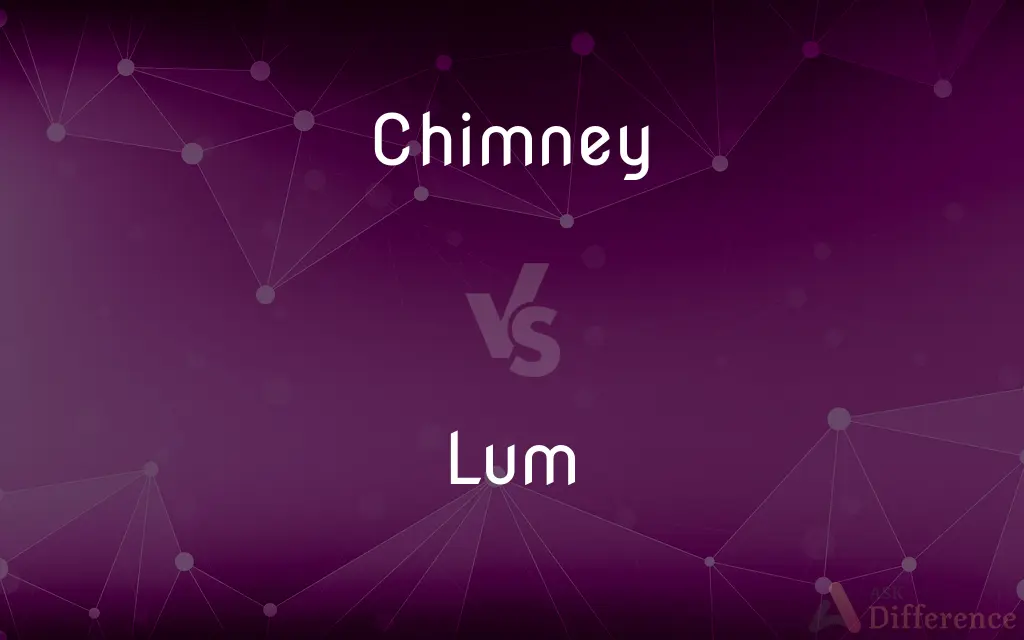Chimney vs. Lum — What's the Difference?
By Tayyaba Rehman & Fiza Rafique — Updated on April 5, 2024
A chimney is a structure for venting smoke from a fireplace or furnace; a lum, in Scottish terminology, specifically refers to a chimney.

Difference Between Chimney and Lum
Table of Contents
ADVERTISEMENT
Key Differences
A chimney is an architectural element found in buildings, designed to safely vent smoke and gases from fireplaces, stoves, or furnaces to the outside atmosphere. It is a critical component for fire safety and air quality within a building, often made of brick, metal, or stone. A lum, on the other hand, is a term used primarily in Scotland to refer to a chimney. The word "lum" is specific to Scottish English and dialects, and while it serves the same purpose as the more widely used term "chimney," its usage is largely confined to Scotland.
Chimneys can vary greatly in size, shape, and design, serving both functional and aesthetic purposes in a variety of buildings around the world. The concept of a lum encompasses the same architectural function as a chimney, focusing on the ventilation of smoke from indoor fires.
Both chimneys and lums are integral to the design of buildings where indoor heating or cooking facilities that produce smoke are present. They ensure that smoke, potentially harmful gases, and particulate matter are efficiently directed away from the indoor living spaces, maintaining a safe and comfortable environment for the inhabitants.
The construction and maintenance of chimneys and lums are subject to building codes and regulations, which may vary by region but generally include specifications to prevent fire hazards and ensure proper ventilation. This includes requirements for height, material strength, and clearance from combustible materials.
While "chimney" is the term used internationally, the preference for "lum" in Scotland reflects the cultural uniqueness and linguistic heritage of the region. Regardless of the term used, the essential function and importance of these structures in residential and industrial buildings remain the same.
ADVERTISEMENT
Comparison Chart
Definition
A structure for venting smoke to the outside
Scottish term for chimney
Usage
Worldwide
Primarily in Scotland
Construction
Made of brick, metal, or stone
Also made of brick, metal, or stone
Function
Vent smoke from fireplaces or furnaces
Same as chimney
Architectural
Varied designs and sizes
Design and size can vary, similar to chimney
Regulations
Subject to building codes
Also subject to building codes
Cultural Aspect
Used in various cultural contexts
Reflects Scottish linguistic heritage
Compare with Definitions
Chimney
Subject to safety regulations.
The chimney was inspected for compliance with fire safety codes.
Lum
Scottish for chimney.
Ye cannae have a fire without a clean lum.
Chimney
Integral to buildings with fireplaces.
The old mansion had a large central chimney.
Lum
Integral to traditional Scottish homes.
A warm fire blazed under the old stone lum.
Chimney
Can be a decorative element.
The chimney was adorned with intricate carvings.
Lum
Found in Scottish architecture.
The cottage had a quaint, smoking lum.
Chimney
Requires maintenance.
We had the chimney cleaned before winter.
Lum
Also subject to safety checks.
The lum was inspected for blockages.
Chimney
A vertical structure for venting smoke.
Smoke rose from the house's brick chimney.
Lum
Part of Scottish linguistic heritage.
Fix the lum is a common phrase in Scotland.
Chimney
A chimney is an architectural ventilation structure made of masonry, clay or metal that isolates hot toxic exhaust gases or smoke produced by a boiler, stove, furnace, incinerator or fireplace from human living areas. Chimneys are typically vertical, or as near as possible to vertical, to ensure that the gases flow smoothly, drawing air into the combustion in what is known as the stack, or chimney effect.
Lum
A chimney; also, the top part of a chimney.
Chimney
A passage through which smoke and gases escape from a fire or furnace; a flue.
Lum
A ventilating chimney over the shaft of a mine.
Chimney
The usually vertical structure containing a chimney.
Lum
A grove or wood; also, a woody valley.
Chimney
The part of such a structure that rises above a roof.
Lum
A deep pool, especially one in a riverbed.
Chimney
Chiefly British A smokestack, as of a ship or locomotive.
Lum
A chimney.
Chimney
A glass tube for enclosing the flame of a lamp.
Lum
A ventilating chimney over the shaft of a mine.
Chimney
Something, such as a narrow cleft in a cliff, resembling a chimney.
Lum
A woody valley; also, a deep pool.
Chimney
A vertical tube or hollow column used to emit environmentally polluting gaseous and solid matter (including but not limited to by-products of burning carbon- or hydrocarbon-based fuels); a flue.
Chimney
The glass flue surrounding the flame of an oil lamp.
Chimney
(British) The smokestack of a steam locomotive.
Chimney
A narrow cleft in a rock face; a narrow vertical cave passage.
Chimney
A vagina.
Chimney
A black eye; a shiner.
Chimney
(climbing) To negotiate a chimney (narrow vertical cave passage) by pushing against the sides with back, feet, hands, etc.
Chimney
A fireplace or hearth.
Chimney
That part of a building which contains the smoke flues; esp. an upright tube or flue of brick or stone, in most cases extending through or above the roof of the building. Often used instead of chimney shaft.
Hard by a cottage chimney smokes.
Chimney
A tube usually of glass, placed around a flame, as of a lamp, to create a draft, and promote combustion.
Chimney
A body of ore, usually of elongated form, extending downward in a vein.
Chimney
A vertical flue that provides a path through which smoke from a fire is carried away through the wall or roof of a building
Chimney
A glass flue surrounding the wick of an oil lamp
Common Curiosities
Are lums different in structure from chimneys?
No, lums and chimneys function the same way and can have similar structures; "lum" is simply the Scottish term for chimney.
Why is maintenance important for chimneys and lums?
Regular maintenance, such as cleaning and inspection, is crucial to prevent blockages, reduce fire risks, and ensure efficient ventilation.
Is the term "lum" used outside of Scotland?
While "lum" is specifically Scottish, it may be recognized or used by people familiar with Scottish culture or dialects outside of Scotland.
How does the design of a chimney or lum affect its function?
The design, including height and material, influences the draft and efficiency of smoke ventilation, with taller chimneys generally providing better draft.
What is the main purpose of a chimney or lum?
To safely vent smoke and gases from indoor fires to the outdoors, preventing indoor air pollution and fire hazards.
Can a building have more than one chimney or lum?
Yes, larger buildings or those with multiple fireplaces may have several chimneys or lums to accommodate different fires.
How has the design of chimneys and lums evolved?
While traditional designs remain, advancements have led to more efficient, safer, and sometimes more decorative designs to match modern architectural styles.
What are some common issues with chimneys and lums?
Common issues include blockages from soot or debris, structural damage, and inadequate draft, which can lead to smoke entering the living spaces.
Do modern buildings still use chimneys or lums?
Yes, chimneys and lums are still used in modern buildings, especially those with wood-burning stoves, fireplaces, or certain types of heating systems.
Can chimneys or lums be retrofitted or added to existing buildings?
Yes, with proper planning and adherence to building codes, chimneys or lums can be added to existing structures to accommodate fireplaces or stoves.
Share Your Discovery

Previous Comparison
Turnip vs. Rutabaga
Next Comparison
Zero vs. NullAuthor Spotlight
Written by
Tayyaba RehmanTayyaba Rehman is a distinguished writer, currently serving as a primary contributor to askdifference.com. As a researcher in semantics and etymology, Tayyaba's passion for the complexity of languages and their distinctions has found a perfect home on the platform. Tayyaba delves into the intricacies of language, distinguishing between commonly confused words and phrases, thereby providing clarity for readers worldwide.
Co-written by
Fiza RafiqueFiza Rafique is a skilled content writer at AskDifference.com, where she meticulously refines and enhances written pieces. Drawing from her vast editorial expertise, Fiza ensures clarity, accuracy, and precision in every article. Passionate about language, she continually seeks to elevate the quality of content for readers worldwide.














































